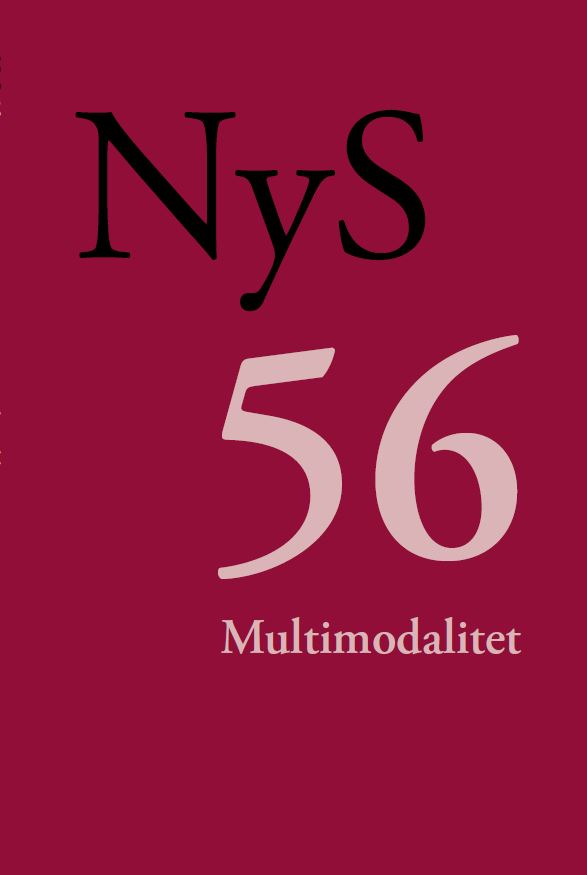Learning to shift gears? A multimodal approach to plot in the literary text
DOI:
https://doi.org/10.7146/nys.v1i56.112649Keywords:
multimodal social semiotics; literary analysis; narrative; plot; multimodal realisation of plotAbstract
With a point of departure in multimodal social semiotics, this article presents a multimodal approach to narrative with special focus on plot in the literary text. We argue that plot is a characteristic of literary texts that is realized multimodally through images, graphic elements, verbal language, layout and typography. Through an analysis of Dorthe Nors’ novel Mirror, Shoulder, Signal, we demonstrate both the cogency of a multimodal social semiotic analysis of a novel that does not explicitly foreground its multimodality and the analytical advantages of incorporating plot as a central concept in analysis. This article’s primary contribution to research in multimodal social semiotics is in incorporating plot in multimodal analysis and in doing so, showing how the narrative category of plot, which is often conceived of as a purely verbal construction designed by the author, can be seen as the result of choices made among different semiotic resources and at different levels of realization.
References
Barthes, R. 1967. Elements of semiology. New York: Hill & Wang.
Breindl, E., A. Volodina & U.H. Waßner. 2014. Handbuch der deutschen Konnektoren 2 bind 1. Boston: de Gruyter.
Brooks, P. 1984. Reading for the plot. Cambridge, Mass.: Harvard University Press.
Bruner, J. 2001. The Narrative Construction of Reality. Critical Inquiry 18. 1-21.
Chatman, S. 1978. Story and discourse. Narrative structure in fiction and film. Ithaca: Cornell University Press.
Genette, G. 1980. Narrative discourse. An essay in method. J.E. Lewin (oversætter), J. Culler (forord). Ithaca: Cornell University Press.
Genette, G. 1997 [1987]. Paratexts: Thresholds of interpretation. Cambridge: Cambridge University Press.
Gibbons, A. 2012. Multimodality, cognition, and experimental literature. London: Routledge.
Grice, H.P. 1975. Logic and Conversation. P. Cole & J.L. Morgan (red.), Syntax and semantics, Vol. 3 Speech Acts, 41-58. New York: Academic Press.
Halliday, M.A.K. 1978. Language as a Social Semiotic. London: Arnold.
Halliday, M.A.K. 1979. Modes of meaning and modes of expression: types of grammatical structure and their determination by different semantic functions. D. J. Allerton, E. Carney & D. Holdcroft (red.), Function and Context in Linguistic Analysis: Essays Offers to William Haas. Cambridge: Cambridge.
Halliday, M.A.K. 1994. An introduction to functional grammar (2. udg). London: Arnold.
Halliday, M.A.K. & C.M.I.M. Matthiessen. (2000) Construing experience through meaning: a language-based approach to cognition. London: Continuum.
Halliday, M.A.K. & C. M.I.M. Matthiessen. 2013. Halliday’s introduction to functional grammar, 4. udg. London: Routledge.
Hansen E. & L. Heltoft. 2011. Grammatik over det danske sprog, bind 1-3. København: Det Danske Sprog- og Litteraturselskab.
Herman, D. 2003. Introduction. D. Herman (red.), Narrative theory and the cognitive sciences, 1-30. Stanford: CSLI.
Hjelmslev, L. 1993 [1943]. Omkring sprogteoriens grundlæggelse. Travaux du Cercle Linguistique de Copenhague XXV. Copenhagen: The Linguistic Circle of Copenhagen.
Hühn, P. 2008. Functions and forms of eventfulness in narrative fiction. J. Pier, J. & J.A.C. Landa (red.), Theorizing narrativity, 143-163. Berlin: de Gruyter.
Jacobsen, H.G. & P.S. Jørgensen. 2013. Håndbog i Nudansk. København: Politikens Forlag.
Kafalenos, E. 2001. Reading visual art, making — and forgetting — fabulas. Narrative 9(2). 138-145.
Kress, G. 2010. Multimodality: A social semiotic approach to contemporary communication. London & New York: Routledge.
Kress, G. & T. van Leeuwen. 1996. Reading images: The grammar of visual design. London: Routledge.
Kress, G. & T. van Leeuwen. 2001. Multimodal discourse: The modes and media of contemporary communication. London: Arnold.
Kress, G. & T. van Leeuwen. 2002. Colour as a semiotic mode: Notes for a grammar of colour. Visual Communication 1(3). 343-368.
Kukkonen, K. 2011. Comics as a test-case for transmedial narratology. SubStance 40 (1). 34-52. DOI: https://doi.org/10.1353/sub.2011.0005.
Kukkonen, K. 2014a. Bayesian narrative: Probability, plot and the shape of the fictional world. Anglia 132(4). 720-739. DOI 10.1515/anglia-2014-0075.
Kukkonen, K. 2014b. Plot. P. Hühn m.fl. (red.), The living handbook of narratology. Hamburg: Hamburg University. www.lhn.uni- hamburg.de/article/plot (tilgået 18.06.2018).
Leeuwen, T. van. 2006. Towards a semiotics of typography. Information design journal + document design 14(2). 139-155.
Leeuwen, T. van. 2011. The language of colour: An introduction. London: Routledge.
Luke, J. 2013. Writing the visible page: A multimodal approach to graphic devices in literary fiction. Queensland University of Technology: Ph.d.-afhandling. http://eprints.qut.edu.au/63020/ (tilgået 15.1.2016).
Martin J.R. & D. Rose. 2003. Working with discourse. London: Continuum.
Nors, D. 2016. Spejl, skulder, blink. København: Gyldendal.
Ryan, M.-L. 2004. Narrative across media. The languages of storytelling. Lincoln: University of Nebraska Press.
Ryan, M.-L. 2012. Narration in various media. P. Hühn m.fl. (red.), The living handbook of narratology. Hamburg: Hamburg University. http://www.lhn.uni-hamburg.de/article/narration-various-media. (tilgået 04.07.2017).
Squires, C. 2007. Book marketing and the Booker Prize. N. Matthews & N. Moody (red.), Judging a book by its cover: Fans, publishers, designers, and the marketing of fiction, 71-82. Farnham & Burlington, VT: Ashgate.
Sternberg, M. 1978. Expositional modes and temporal ordering in fiction. Baltimore: Johns Hopkins University Press.
Sternberg, M. 2001. How narrativity makes a difference.” Narrative 9(2). 115–122.
Downloads
Published
How to Cite
Issue
Section
License
Forfatteren/forfatterne og NyS har ophavsret til de artikler og anmeldelser der bringes i tidsskriftet. NyS har ophavsretten til den udgivne version af tidsskriftet. Forfatteren har ophavsretten til sin egen tekst. Forfattere kan arkivere den publicerede artikel på deres institutions forskningsarkiv (Institutional Repository) eller en privat hjemmeside, når forfatteren samtidig linker til artiklen med den officielle DOI.
For artikler publiceret i NyS tillades at læsere kan downloade, kopiere, udskrive, søge eller linke til og citere fra artikler til ethvert lovligt formål. Artikler kan frit deles og linkes til på forsknings- og undervisningsnetværk (så som Blackboard, Moodle, Canvas o.a.). Link foretrækkes fordi det giver oplysning om brug af tidsskriftets artikler, og fordi det anerkender tidsskriftets redaktionelle arbejde. NyS tillader ikke at læsere bruger artikler eller dele af dem i egne artikler uden at citere, eller at læsere på anden vis anvender dem til kommercielle formål.





